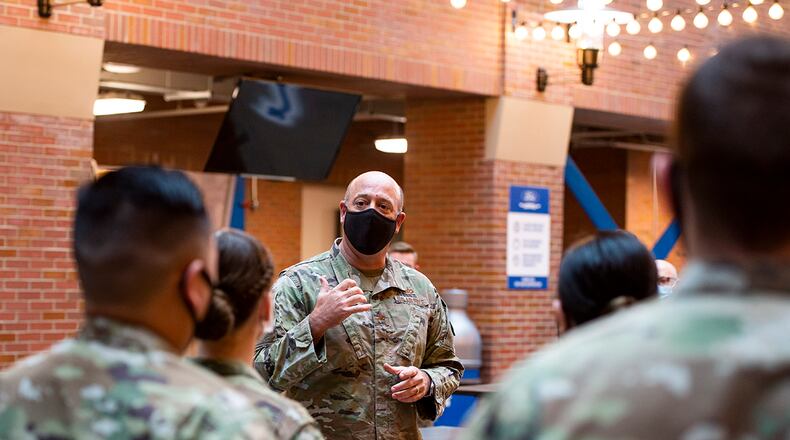Many base workers have been doing their jobs remotely since the spring of 2020, with base leaders gradually allowing more workers to return in the months since.
“What I did not do is declare a new public health emergency,” installation commander Col. Patrick Miller said Wednesday.
That decision gives base leaders and mission commanders more flexibility in an environment where the nation today has more treatment options for COVID and importantly, a vaccine.
Greg Leingang, vice director of the 88th Air Base Wing, said as of now, base supervisors do not have the authority to direct employees to telework.
He noted, in fact, that the base does not have a one-size-fits-all, installation-wide, telework policy. The base is home to about 100 individual organizations, many of them with unique policies.
“That makes it really not practical for the wing to direct a standard telework policy for the (entire base),” Leingang said.
Quite often, Air Force work requires employees to be physically present, he noted.
Still, Miller added: “We’ve seen over the last 18 months how powerful telework can be, and we can get the mission done.”
Both Miller and Leingang encouraged employees and supervisors to discuss the issue and chart their own paths.
Col Christian Lyons, commander of the 88th Medical Group, said of the base’s last 122 COVID-positive cases, 25 were fully vaccinated, about 20%. But of those who were fully vaccinated, none have been hospitalized or exhibited serious symptoms.
Defense Secretary Lloyd J. Austin III is weighing whether to recommend that President Biden make coronavirus vaccinations mandatory for the country’s active-duty troops.
“We’re awaiting higher headquarters guidance,” Miller said.
“Bravo” caps the on-base working population at 50 percent, or about 15,000 people. Miller said physical distancing and masking will continue to be emphasized. Staffing decisions are left to mission commanders.
The cap on large gatherings has also been lowered to 50 people, he said.
Without the declaration of a public health emergency, there are no restrictions on leave and travel, but Miller asked Airmen “to be smart” about travel choices, urging them to stay away from COVID “hot spots.”
The Air Force Marathon and associated events are still on for Sept. 16 to 18, but participants were asked to monitor the marathon web site.
The Department of Defense has protocols for public health emergencies, known as health protection conditions. Commanders update these conditions — sometimes called HPCONs ― based on risk levels within a local community. “Bravo” represents more rigorous safeguards than “alpha.”
With concerns about the COVID “delta” variant mounting, masks and face coverings were made mandatory indoors across the DoD late last month.
Masks are not required outdoors, regardless of vaccination status, for individuals who can maintain physical distancing. People working out in a gym are also not required to wear a mask.
The updated guidance is based on the Centers of Disease Control and Prevention community transmission classification for surrounding areas. As of late July, three of four counties surrounding the base — Miami, Greene and Montgomery — were considered “significant” in COVID transmission, the base said. Clark County was considered “moderate.”
“That got the team going full-bore, saying, ‘Hey, it’s time, it’s time for us to make the switch, it’s time for us to protect the mission,’” Miller said of the decision to require masks anew.
On Wednesday, more than 2,000 daily cases of coronavirus were reported in Ohio for the first time in nearly four months.
The state recorded 2,167 cases in the last day, bringing its total to 1,134,965, according to the Ohio Department of Health. The last time Ohio’s daily cases exceeded 2,000 was in mid-April.
About the Author

